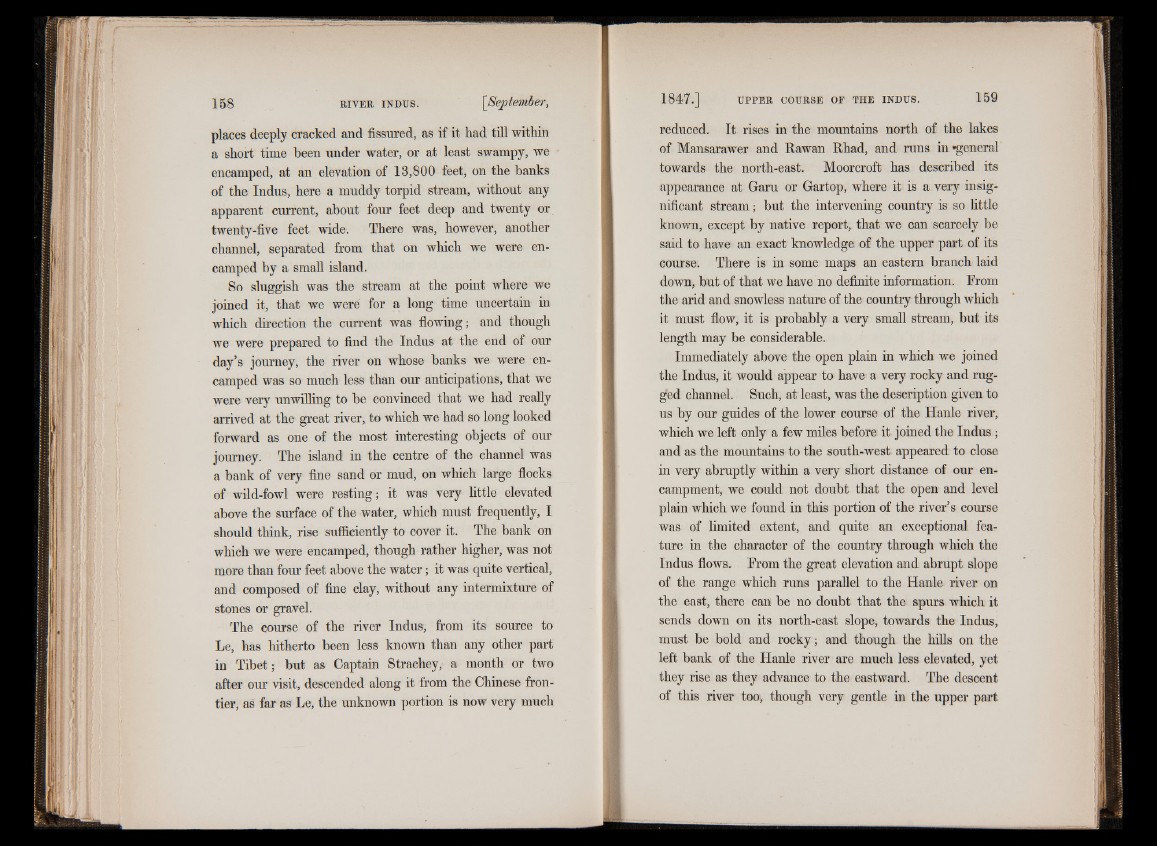
places deeply cracked and fissured, as if it had till within
a short time been under water, or at least swampy, we
encamped, at an elevation of 13,800 feet, on the banks
of the Indus, here a muddy torpid stream, without any
apparent current, about four feet deep and twenty or
twenty-five feet wide. There was, however, another
channel, separated from that on which we were encamped
by a small island.
So sluggish was the stream at the point where we
joined it, that we were for a long time uncertain in
which direction the current was flowing; and though
we were prepared to find the Indus at the end of our
day’s journey, the river on whose banks we were encamped
was so much less than our anticipations, that we
were very unwilling to be convinced that we had really
arrived at the great river, to which we had so long looked
forward as one of the most interesting objects of our
journey. The island in the centre of the channel was
a bank of very fine sand or mud, on which large flocks
of wild-fowl were resting; it was very little elevated
above the surface of the water, which must frequently, I
should think, rise sufficiently to cover it. The bank on
which we were encamped, though rather higher, was not
more than four feet above the water; it was quite vertical,
and composed of fine clay, without any intermixture of
stones or gravel.
The course of the river Indus, from its source to
Le, has hitherto been less known than any other part
in Tibet; but as Captain Strachey,- a month or two
after our visit, descended along it from the Chinese frontier,
as far as Le, the unknown portion is now very much
reduced. It rises in the mountains north of the lakes
of Mansarawer and Rawan Rhad, and runs in »general
towards the north-east. Moorcroft has described its
appearance at Garu or Gartop, where it is a very insignificant
stream; but the intervening country is so little
known, except by native report,, that we can scarcely be
said to have an exact knowledge of the upper part of its
course. There is in some maps an eastern branch laid
down, but of that we have no definite information. From
the arid and snowless nature of the country through which
it must flow, it is probably a very small stream, but its
length may be considerable.
Immediately above the open plain in which we joined
the Indus, it would appear to have a very rocky and rugged
channel. Such, at least, was the description given to
us by our guides of the lower course of the Hanle river,
which we left only a few miles before it joined the Indus;
and as the mountains to the south-west appeared to close
in very abruptly within a very short distance of our encampment,
we could not doubt that the open and level
plain which we found in this portion of the river’s course
was of limited extent, and quite an exceptional feature
in the character of the country through which the
Indus flows. From the great elevation and abrupt slope
of the range which runs parallel to the Hanle river on
the east, there can be no doubt that the spurs which it
sends down on its north-east slope, towards the Indus,
must be bold and rocky; and though the hills on the
left bank of the Hanle river are much less elevated, yet
they rise as they advance to the eastward. The descent
of this river too, though very gentle in the upper part